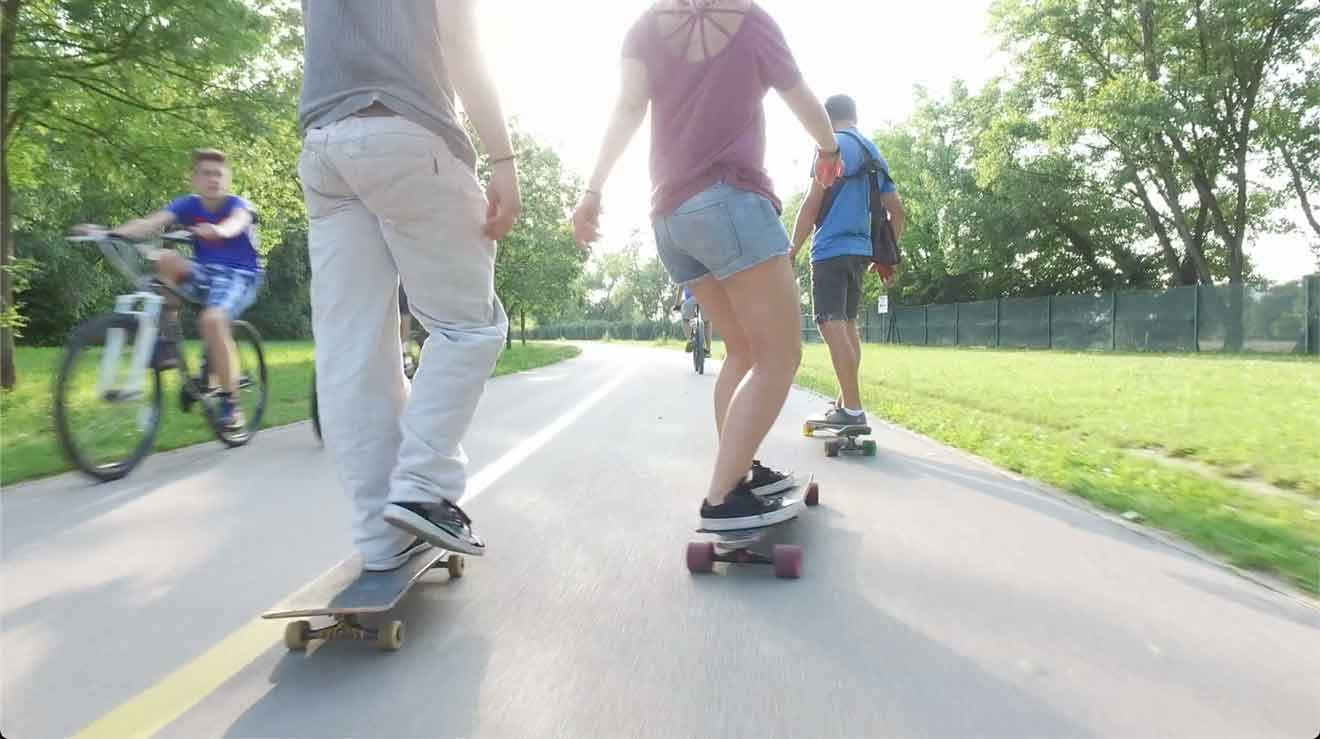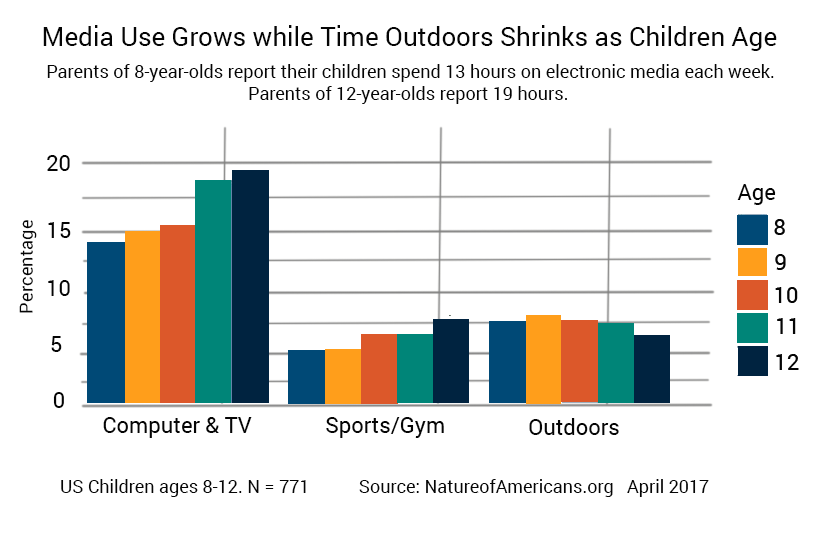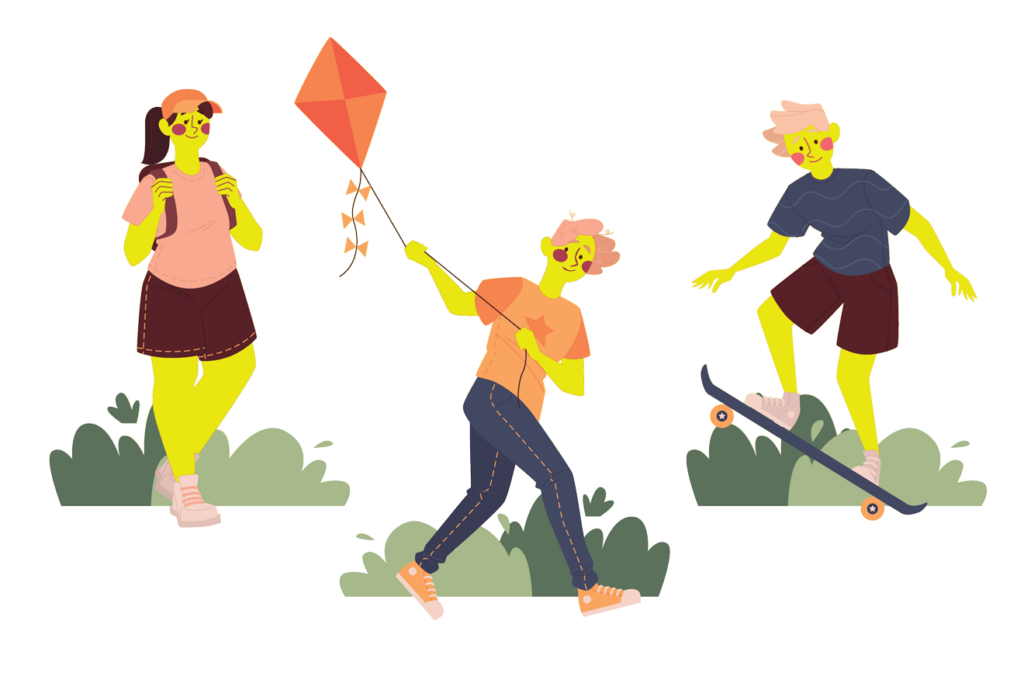A Guide for Teens, Kids, and Parents
How To Turn Off Devices & Play Outside

This guide is full of ideas from real parents who not only got themselves and their kids to play outside but helped change the culture in their neighborhoods to do it. Whether you live in a quiet neighborhood where everyone stays behind closed doors or in an apartment building in a bustling urban center, you’ll find something you or your kids can try—even if you’re not athletic and it’s cold or rainy outside. Read on to learn how to get off your devices and play outside!
In This Article
How to Put Devices Down

How to Get Teenagers Playing Outside

Outside toys – Outside toys are a great way to entice kids of all ages out of the house. Water toys are fun on a hot day. Basketball hoops and soccer goals can lead to neighbors or siblings or you and your teen playing outside together.
Appeal to a teenagers’ need for independence – Bicycles can give teens a new level of mobility before they’re ready to drive. Get them a bike and get them outside and moving in the fresh air.
Use their favorite social media content as a clue – Many teenagers spend their free time viewing the activities of others on social media. Learning what kind of activities your teen likes to watch could help you figure out a way to entice them outside. For example, TikTok is full of roller-skating videos. If your teen likes to watch them, you could encourage them to try skating or skateboarding themselves. If you’re handy, consider building a skate ramp in your backyard and encouraging your teen to invite their friends over to practice.
Take the inside outside – Taking activities outside helps teens get used to the idea that outside can be a place to spend free time. Put a ping-pong table in the garage. Play board games outside. If your teen likes to draw, buy them an outdoor easel or challenge them to take a sketchpad outside and draw something they see. Or get a big piece of plywood and ask them to paint a mural to decorate the backyard.
LARPing– If your teen is really into an MMORPG (massively multiplayer online role-playing game), look for a LARPing, or live action role playing group, in your area. LARPing is the prototype for MMORPG’s except it’s played in real life—and usually in nature! Not only does it entail physical activity, but participants make their own costumes, so it taps into their creativity and imagination, too. Some LARPing events can be pricey, but some that are affordable or even free are Amtgard, Dagorhir, and Belegarth. If there aren’t any LARPing groups near you, consider helping your teen start one in your community.
Video: A short documentary from 2016 on LARPing, or live action role playing, shot at the first battle of the season for the Tir Asleen chapter of Dagorhir in Northern Vermont. On their website, Dagorhir claims to be “the oldest and arguably the largest live-action roleplay / combat organization in the United States, with chapters in nearly every state from Maine to Hawaii, and several others around the globe.” If your teenager loves playing an MMORPG online, they might enjoy LARPing. If there aren’t any such groups in your area, consider helping them found one.
Meet them where they are – If your teen won’t get off social media, offer to take them to an outdoor venue to take some photos for “content”. While you’re there, enjoy a walk and take in all the natural beauty around you.
How to Change a Culture that Doesn’t Prioritize Playing Outside

When contemplating letting their kids play outside, especially unsupervised, parents often cite two fears. Fear of crime and fear of judgment from other parents that can even result in having the authorities called on them. But studies show that kids need a certain amount of unsupervised play, as well as outdoor play, for proper development. So if you live in a neighborhood where there aren’t any kids outside for yours to play with, you have to be the change you want to see. In this section, we’ll discuss some ideas that real parents have used to change the culture in their neighborhoods.

How to Play
Outside in Bad Weather
How to Get Kids to Play Outside in the Winter
Dress Properly – Be sure kids dress in layers that trap body heat. And the American Academy of Pediatrics adds that, as a general rule of thumb, younger children should wear one more layer than adults. Warm boots or shoes, gloves and a hat are also key.
Pack Sustenance – The body burns a lot of calories in the cold so be sure to send kids out with snacks to keep their energy up. Pick foods that don’t freeze easily like cheese, crackers, fig bars, nuts, seeds or trail mix. Kids dehydrate quicker, too, so send them out with a thermos of something warm to give keep them hydrated and make them feel cozy.
Keep Moving – Activities that keep the body moving, like sledding, ice skating, snowball fights, building snowmen or snowforts, and making snow angels, are the best way to go in winter. A great activity to do with your neighbors is to organize a neighborhood scavenger hunt or play winter bingo. Give kids a list to see how many winter items the can spot outside.
Incentivize — Nothing will endear outdoor winter play to kids like cooking outside with the family. Bring thermoses of hot chocolate or tea or cook hot dogs and s’mores over a fire.
How to Get Kids to Play Outside in the Rain
Dress Properly – Rain boots, raincoats/ponchos, and umbrellas
Turn Water into a Toy – One way to get kids excited about outside play is to make it okay to get messy. Jump in puddles, make mudpies, and hunt for worms. You can also build a rain catcher to measure how many inches it rains and have boat races using leaves, nut shells or twigs.
Incentivize – Reward your kids at the end of a long day’s play in the rain with a warm bath and big fluffy towel.
How (And Why) to Find Some Outside Activities of Your Own

Resources to Learn More

Children and Nature Network Research Library – A source for peer-reviewed scientific literature that makes the case for engaging children with nature.
The cognitive benefits of play: Effects on the learning brain – From Parenting Science, the website of Gwen Dewar, Ph.D, who is trained in evolutionary anthropology, behavioral ecology, primatology, and comparative psychology.
The Liink Project – An innovative school model from Texas Christian University based on improved brain development as a result of physical activity and outdoor exposure throughout the day, and character development taught daily.
IPA-USA – An interdisciplinary non-governmental organization providing advocacy for the promotion of play opportunities for children
Recess Advocacy with Summer Belloni – Episode 45 of Happy Outdoor Families, the podcast that encourages and equips families to spend more time exploring and playing together outside.
Sources
- Yogman, M. (2018, September 1). The Power of Play: A Pediatric Role in Enhancing Development in Young Children. American Academy of Pediatrics. https://publications.aap.org/pediatrics/article/142/3/e20182058/38649/The-Power-of-Play-A-Pediatric-Role-in-Enhancing
- Kellert, S., Case, D., Escher, D., Witter, D., Mikels-Carrasco, J., & Seng, P. (2017, April). The Nature of Americans: Disconnection and Recommendations for Reconnection. Natureofamericans.Org. https://natureofamericans.org/
- Brussoni, M., Lin, Y., Han, C., Janssen, I., Schuurman, N., Boyes, R., Swanlund, D., & Mâsse, L. C. (2020). A qualitative investigation of unsupervised outdoor activities for 10- to 13-year-old children: “I like adventuring but I don’t like adventuring without being careful.” Journal of Environmental Psychology, 70, 101460. https://doi.org/10.1016/j.jenvp.2020.101460
- U.S. Department of Health and Human Services. (2018) Physical Activity Guidelines for Americans, 2nd edition. Washington, DC: U.S. Department of Health and Human Services. https://health.gov/our-work/nutrition-physical-activity/physical-activity-guidelines/current-guidelines
- Kellert, S., Case, D., Escher, D., Witter, D., Mikels-Carrasco, J., & Seng, P. (2017, April). The Nature of Americans: Disconnection and Recommendations for Reconnection. Natureofamericans.Org. https://natureofamericans.org/


